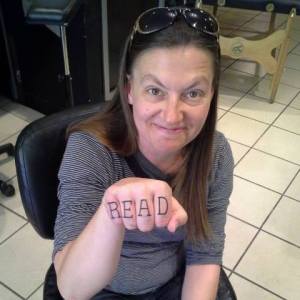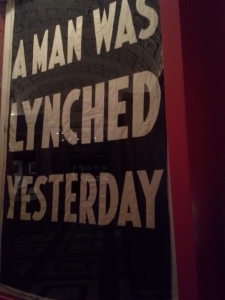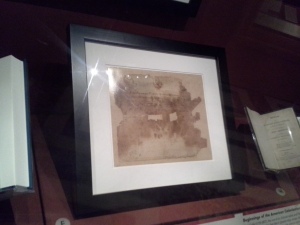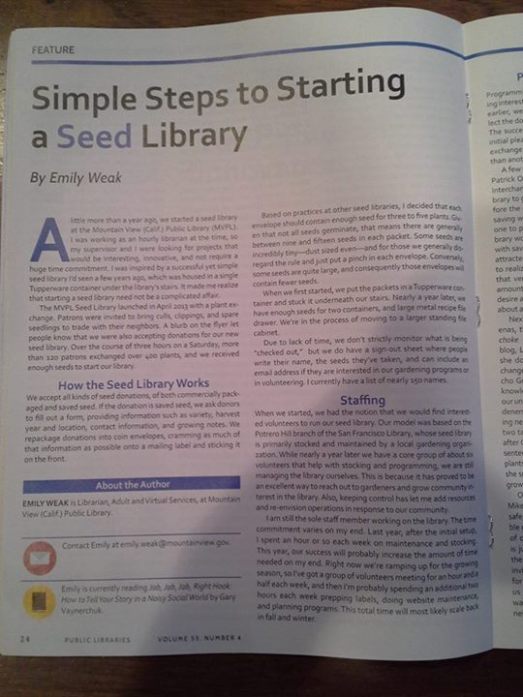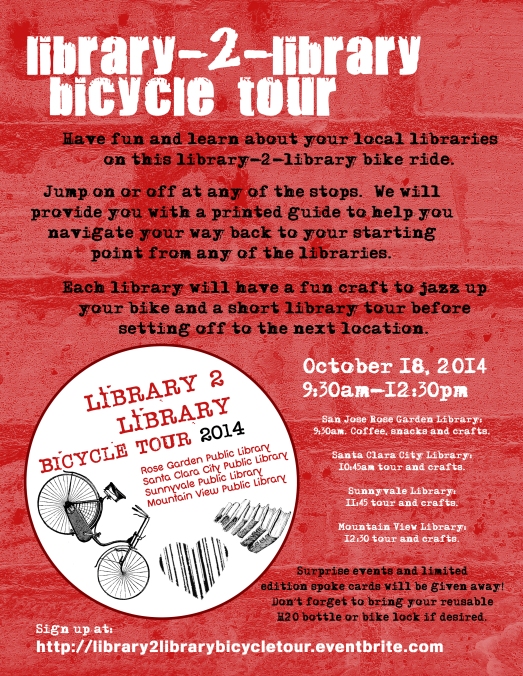I’m at the California Museum Association conference, learning that the museum zeitgeist is in a similar place to the library zeitgeist. They’re focusing on community engagement and experiences, and trying to balance what it takes to attract new audiences with what core members expect. They’re moving from the stewardship of things to the cultivation of people.
Thursday I went to:
Meaningful Community-Centered Engagement: Lessons Learned
Moderator: Lisette Islas, Director of Partner & Civic Engagement, San Diego Grantmakers. Presenters: Rob Sidner, Director, Mingei International Museum; Gwen Gómez, Manager of Community Programs and Bilingual Initiatives, San Diego Museum of Art, San Diego Museum of Art; Micah Parzen, CEO, San Diego Museum of Man.
This session described how The Jacobs Center for Neighborhood Innovation worked with three museums to engage citizens from San Diego’s Diamond neighborhood. Moderator Lisette Islas described how she had found that the arts were a great carrot for involvement; asking folks to help plan a celebration of their culture got a lot more involvement than asking folks to come to a housing meeting.
She described how a donor had asked her to put together a collaborative project that would involve Diamond Residents and the Balboa Park museums. Initial meetings allowed people to break bread with each other and provided plenty of time to talk and plan.
Islas told a story about a Somali refugee: this woman had never been to a museum, and had no idea what they were about or how to act in one. She would not take her kids to a museum, because she couldn’t help them with the experience – she had no context, and couldn’t help them to behave properly. They realized they might need to provide an exhibit from the museum, outside the museum. They realized they needed to be PROACTIVE in showing people how to experience their institutions, and in inviting people in.
Projects developed included: kids from the neighborhood made murals, and then people from the neighborhood came to the museum to see what their youth had done. A Behind the scenes at the museum event, which created a magic moment. A project(s) on the theme Rites of passage.
On a five year trajectory, OUTCOMES for Mingei included working toward staff parity (40% of San Diego is Mexican-American but this is not reflected in staff) and funding a Community Relations Manager – who works with staff to help them be more engaged with the community.
Some advice:
- On Managing multiple stakeholders (aka pleasing everybody): Build consensus with who you have, then defend your process.
- Believe in yourself, but allow yourself to change.
- It’s uncomfortable, but don’t be afraid to ask your audience, “how are we failing you and why?”
- Make a space for others to lead.
- You can’t please everyone, but you gotta stay at the table.
- If we are truly committed to community engagement, this work needs to be built into the budget, not grant-funded
Audience question mentioned School in the Park which sounds AWESOME, an experiential learning lab which uses museums and Balboa park as a classroom.
Translating to libraries, and other thoughts:
What are carrots a library can provide? Literacy? Stories
Libraries can be community connectors too.
Find an organization that’s engaged in the community and jump on board. Collaborate with peers in doing so. Discuss processes openly.
Do people want to see behind the scenes at the library?
Should we bus people into libraries?
Should we invite neighborhood associations in for a tour and mixer?
- Annually? Meet your neighbors @the library.
Partner with a museum to create a library exhibit?
Presentation alluded to “museum manners,” the idea that there’s a certain way to behave in a museum, talking about how project worked with people so “they know how to act.” For an inspiring presentation about a project that truly was “of the people, by the people, and for the people,” I found the existence of museum manners a bit of an anachronism. Aren’t we working toward “be yourself” manners? “Library manners” are a thing too, and a lot of old audience/new audience conflict surrounds the idea that new library patrons aren’t acting correctly. We’re relaxing a lot of traditional library rules in order to meet a wider audience – the new library is not quiet.
BUT, there’s also the idea that manners allow people to feel more comfortable by ensuring that we are behaving in a way that is not causing ourselves or another person distress. Non-audiences might want to be inducted into “proper behavior,” might feel more comfortable and empowered if they have knowledge of the “correct” way to behave. Breaking the rules of library manners has been a privilege of and conversation amongst those who already know the rules.
Session 2E: Putting the Fun in Profundity: A Conversation About Compelling Museum Social Justice Work
Moderator: Ben Garcia, Deputy Director, San Diego Museum of Man. Presenters: Lisa Sasaki, Director, Audience & Civic Engagement Center, Oakland Museum of California; Sheri Bernstein, Vice President of Education, Skirball Cultural Center.
This presentation talked about the ways that fun and the profound can appear together at the museum. The pursuit of social justice (fair distribution of wealth, opportunities and privileges) is richer and more effective if fun is part of the equation.
If we include an institutional intent for Social justice, this can often be at odds with a perceived need for neutrality. However, social justice seeking is ok. It’s good to pursue JOY-CENTERED work. What is fun? Fun is: quality family time. Fun is: pleasure without guilt. Participation is fun Creativity is fun Generative is fun. Balance the best and worst of humanity with a wellspring of joy. (Anthropology’s dark history is a one-way view that is very privileged. How do we translate to a new present? By joining the fun and the profound.)
At the Museum of Man, they put together an exhibit of Native American Skateboard art, and included a half-pipe (with skateboarders) as part of the exhibition. This upset some of their traditionally-minded stakeholders, but brought a lot of new interest from the city.
Museum of Man has two exhibits: Beerology, 2000 years of brewing history, which includes beer tasting, and Empowering Women, which talks about female co-ops around the world. These exhibits are adjacent to each other and in this way the earnest and inspiring and the FUN share the same space.
Their Monsters exhibit was cross-cultural, engaging, diverse, and FUN, but was it profound? No really.
Will this be true for your visitors? “I am inspired to seek out other transformative experiences”
The Skirball museusm, a Jewish American Cultural Center, includes as part of their mission the wish to “create a society in which everyone can feel at home. They created a Noah’s Ark exhibit, which serves as an introduction for proFUNd experiences. The exhibit tells a horizontal story about all the creatures of the world – that everyone is welcome in Noah’s ark.
One exhibit they created was called “Build a Better World.” The wooden frame of a house was adorned with cards describing families that Habitat for Humanity was building homes for. Visitors could write a welcome card for a family. It also included a store where kids could use play money to buy real groceries for the families. This exhibit/activity was do-able, open-ended, and had a story tie-in.
I found this whole program compelling, but was especially moved by how Sheri Bernstein expressed the Skirball’s pursuit of it’s mission. Her idea of fun is authentic, but open to risk taking and failure.
Museum people can tell a good story.
Sometimes you have to “make it palatable,” to create stealth social justice. Fun can still be profound.
The Oakland Museum of California has a Friday night program which is successful. Friday nights will include a community partner and social justice element. The want to amplify community voices. They also have a program which is Community Healing through Song, where a musician works with a community to create an original song.
Adversity and Opposition:
- fun is different things to different people
- you can let go of some stakeholders
- Embrace the critique as an INTENTION, reframe the conversation as “Yes! Let’s talk about this. We *are* starting this conversation”
- People will come to fun.
Welcome is intrinsic to doing Fun & Good Work. Identity is intrinsic to doing Fun & Good Work. Enjoy yourself and do good at the same time.
Library thoughts:
Libraries are supposed to be neutral too. We need a Vatican II for libraries.
Should we do a “Night at the Library”?
Libraries, like museums, are moving from being grounded in objects to grounded in experiences.
Session 3C: Creating Meaning Through Crowd-sourced Content
Moderator: Susanne Clara Bard, Content Developer, Coast to Cactus in Southern California, San Diego Natural History Museum. Presenters: Wes Hsu, UX/UI Designer, Balboa Park Online Collaborative; Joaquin Ortiz, Director of Education and Innovation, Museum of Photographic Arts.
The San Diego Natural History Museum included crowd-sourced content in their Coast to Cactus Exhibit, including oral histories about camping in Southern California. Bard played an interview with a little girl who had some great observations, including that camping allows you to see what life was like when we didn’t exist, and that nature doesn’t hurt your brain cells. They also included a memory tree, where people could respond to a prompt.
Hsu talked about a project working to get people to develop their own exhibit. They had a tile wall where people could create their own galleries. They produced simple themes like “trees” and “my favorites” Hsu said that the application was not shallow enough – there were too many steps and people got bored. He concluded that people don’t want to think. They want a lighter experience that they can enjoy with their date or family. Libraries should keep it simple stupid.
At this point, I skipped over to a concurrent session:
Inspiring Guests to Take Action
Moderator: Amy Miller, Director of Public Programs, California Academy of Sciences. Presenters: Nette Pletcher, Director of Conservation Education, Association of Zoos and Aquariums; Charina Cain Layman, Education Manager, Birch Aquarium at Scripps Institution of Oceanography; Maya O’Connor, Senior Educator, San Diego Zoo Global.
World Oceans Day (at the San Diego Zoo?) was an exhibit that included Action Ask cards (asking the guest to take an action on leaving the museum), as well as an activity and story. It transmitted the idea that small actions could influence the larger community. Founded on the Touch the Heart, Change the Mind principle.
I didn’t stay for a lot of this presentation, but they talked about how Telling a Story can change behavior and create an advocate. The San Diego Zoo also talked about how it’s important to inspire employees, and then they will go on to inspire guests.
Finally I caught the last half hour or so of a third concurrent session:
Using Public Programs as a Pathway to Engage Diverse Visitors: Strategies for Audience Development and Ensuring Relevance
Moderator: Stacy Lieberman, Executive Vice President and Deputy Director, Autry National Center of the American West. Presenters: Grant Barrett, Marketing Manager, San Diego Museum of Man; Robyn Hetrick, Director, Programs and Public Events, Autry National Center of the American West; January Parkos Arnall, Curatorial Assistant, Public Engagement, Hammer Museum.
The Autry Museum started a program of movies on the lawn, which were very popular. They created exhibit tie ins, which sometimes were a reach but were ultimately pretty successful (e.g. Jaws and Dangerous Animals of the American West). They also created a program in partnership with American Girl. The flyer was in the American Girl store and that gave the Autry Museum a HUGE publicity boost. Robyn Hetrick said that you need to put partners through your rubric to make sure it’s worth it, but that there can be huge returns.
This presentation explored more of the conflict between core members and new visitors. Core members seem to be associated with staid, quiet and contemplative museums, whereas new visitors are drawn by boisterous fun and unusual partnerships. However, increasing visibility and visits with boisterous fun can still boost attendance to the contemplative programs – for example one panelist said they were now getting audiences of 100+ at scholarly lectures.
Through the use of timing, and by having a varied portfolio of programs, a museum can still serve both audiences. Marketing methods (social media v. paper) can help you reach the audience that’s most appropriate for your program.
They also discussed internal conflicts. Some museum have programming in more than one department – scholarly and public programs, for example, and the museum resources are prioritized in such a way that not everyone can win all the time. They discussed the value of having a marketing voice at the table from the beginning, to help make choices that would happen at the right time for success. ROI was brought up as an important consideration. What is the museum making from memberships v. donors v. event tickets? Is just holding the event enough of a success, or are you hoping for other outcomes? Are you trying to maximize the one-time interest revenue? Are you getting millennials into the museum? (millennials are not museum members) They referenced the LaPlaca-Cohen study. Are these one night stands worth it?
Ticket prices rule out some audiences. It’s important to figure out what price your audience is willing to pay. But, you may want to increase pricing for people who won’t become members.
The Autry museum created a successful event where people were invited to Curate a Gallery by making storyboards.
How do you track success and demographics? Can watch who’s coming in (but demographic info is often not visible). The audience showing up – that’s the survey. Hold events that draw in the audience, and then fine-tune further events once you know who’s showing up.
The Hammer museum replaced security guards with Museum Experience Representatives, who were trained to see if someone was struggling with content or open to guidance. They had training in how to help the audience appreciate a more complex work, in how to approach a visitor with kids, etc.
We carefully curate our own lives. To be surprised is a breath of fresh air.
Good stories can take you far down the path.

